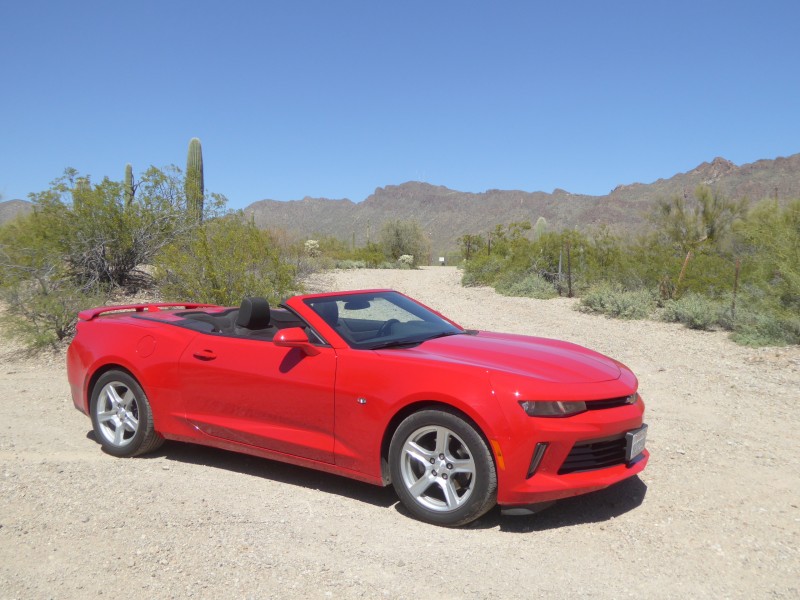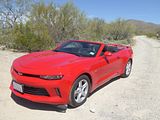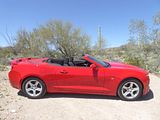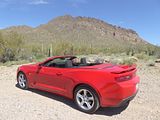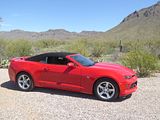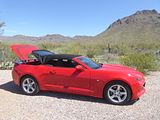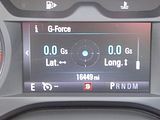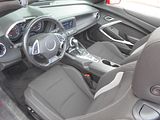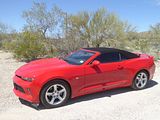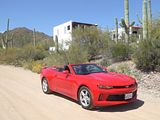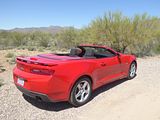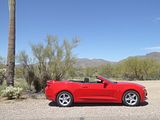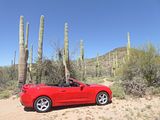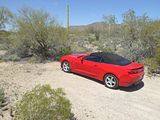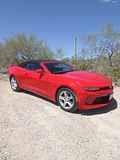In recent years the number of convertibles on offer has reduced markedly. But you can still pursue that American dream of a vacation driving a sports car, roof down, enjoying sunny skies and the sensation of fresh air. You will need to pick the right part of America, as well, of course, but in those States where the likelihood of being able to drive roof down are good then the rental car companies do still have open-topped cars on fleet. There are the odd prestige-badged cars that you may come across, but really your choice is going to come down to a Mustang or a Camaro. Both are true US icons, of course, with a long and illustrious past that was given a strong rebirth around 15 years ago with the launch of a new retro-styled Mustang in 2004 and a somewhat belated response from GM and Dodge with the reappearance of the Camaro and Challenger that had been strong rivals back in the real Muscle Car era of the late 1960s. Sales of all three were strong, so their makers have kept them in their respective ranges ever since. The Camaro underwent more of a change than may be obvious from its looks with the sixth generation car that appeared in May 2015. Most of the important changes were underneath with the adoption of the rear wheel drive GM Alpha platform, which it shares with the Cadillac ATS and CTS. The new car was slightly smaller than its predecessor and more importantly was quite a bit lighter which augured well for the way it would drive. I was a huge fan of the fifth generation Camaro, with its looks winning me over, even before I got to drive it, and my enthusiasm only increased when I got behind the wheel of a bright yellow V8 powered SS in early 2010. A bright red convertible version a couple of years later appealed even more and at the time I decided that this was my pick of the trio of new Muscle Cars. A test of the V6 coupe showed me that even in less potent form, it was still very appealing. The new car did not quite hit the same spot visually, sadly, even though the overall shape is very similar and a test of a 2018 model year Coupe in September 2017 left me feeling a bit disappointed. I did want to try to the Convertible, as I thought that some open-topped motoring might just make fall in love with the Camaro all over again. My chance came when I spotted a bright red model being parked up in the Presidents Circle area of the rental car facility at the Phoenix Sky Harbor airport, and I made a beeline for the car before anyone else did. I had the car for one day to see what I thought.
As this was a convertible, it would have been an opportunity missed not to put the roof down, even when I collected the car in the evening and the dark. That’s a very simple process provided that the divider in the boot is correctly in place. And if its not, there a warning the dash telling you so, and the roof simply won’t move. Once it is, though, you simply press the button and the all electric roof just powers down and out of the way, leaving a nice clean appearance to the car. Like most convertibles, I think the car looks pretty good roof down, but even with it in place, this one looks better than most, with the roof following the outline of the coupe fairly closely. The following morning, I set off on the freeway with the roof down, and provided the side windows are up there is no buffeting to speak of, though if you want to listen to the radio, you will need to increase the volume quite a lot.
I was in no doubt as to the engine of the test car as soon as I started it up, as the only word I can use to describe it is “meh”, whereas previous experience of earlier Camaro models with the V8 and even the V6 had suggested excitement even before engaging gear. Yes, this was the 2,0 litre turbo 4. It develops 275 bhp, which is quite a bit down on the V6 model, but actually, although the noise it makes is disappointing don’t write it off just like that, as actually, it proved quite lusty and the Camaro was surprisingly rapid. There are paddles, but if you leave the 8-speed transmission to sort itself out, as I did, it will find the appropriate gear and thanks to a healthy 295 lb/ft of torque, there is plenty of acceleration available in the mid-range and even from relatively low revs, the car picks up speed well. Once at cruising speed, engine noise is quite well subdued, but if you are driving with the roof down, as I was, there will be other sources of noise that dominate, anyway. One of the reasons for the 4 cylinder unit, of course, was for better fuel economy, I drove 256 miles during the day I had this Camaro, and it needed 9.2 gallons to fill it up again, which computes to 27.82 mpg US, or 32.9 mpg Imperial, an impressive figure and one that the V6 could not even hope to match, let alone the V8 models. It is worth noting that I achieved a similar figure when I tested the Coupe, so this would seem to be the sort of economy you could expect from the car.
The other driving dynamics are well sorted, too. There is a choice of three driving modes, selected by a rocker switch in the centre console. These are tourist, sport and snow, and as you might expect, they alter the throttle response, transmission settings and steering weight. I left the car in tourist mode for most of my test. One advantage of the 4 cylinder engine is that it is somewhat lighter than the larger units, so there is less weight in the nose and that is probably no bad thing. The steering has plenty of feel to it, and is well weighted so the car is not heavy to drive, and indeed is easily manoeuverable, but you always know what the steered wheels are going to do. It corners flat, with no body roll to speak of and there is plenty of grip and the handling is well judged. The car felt rigid with no evidence of scuttle shake. No question, this was a fun car to punt along twisty roads. The ride is on the firm side but it did not prove uncomfortable, though it should be pointed out that this test was in Arizona where the road surfaces are generally good, This version of the Camaro comes on relatively small 245/50 R18 wheels. The brakes are powerful, too, bringing the car to halt with no concerns. Like so many cars now, this version of the Camaro has an electronic handbrake, but as the car is also an automatic, this really does not matter at all and it does free up a bit of space in the centre console. As to visibility, well, with the roof down, there is a great all round view and seeing behind you is not hard. But put the roof up and things are rather different, with the rear-view camera helping you to judge the back of the car, but no help with over the shoulder views in traffic. You sit low, so judging the front and even the sides of the car is not that easy and this is one of the frequent complaints about the car, though I thought some of those moans are perhaps a little overstated.
Chevrolet made a major effort with this generation of Camaro to improve the perceived quality of the interior and by and large, they have succeeded, with far nicer quality materials than was the case before with plenty of soft-touch surfaces and considered use of chrome highlighting to complement the black finish. It is better than the last generation model for sure, but I think the latest Dodge Challenger does it rather better. The previous generation Camaro interior had decided retro styling cues, but these seem to have been toned down a bit and there are plenty of individual components which have come from the GM parts bin. The dash of the convertible is the same as that of the coupe, which is not really a surprise. The leather-wrapped steering wheel proved pleasant to hold. There is keyless starting, with a button to press to the right of the steering wheel. Presented in a curved binnacle, as opposed to the very squared off one of the previous generation, there are two large instruments dials and two smaller ones in the upper central area between them, all clearly marked and easy to read. Beneath them is a digital display where the options include some sports car data points such as acceleration and a G-force meter and you can select these from buttons on the right hand column spoke. There are two GM-universal column stalks for indicators and lights on the left of the wheel and wipers on the right, both having the slightly serrated end to them which I do not particularly like. Mounted on the steering wheel hub are buttons for cruise control and audio repeater functions. The centre of the dash contains the integrated 7″ colour screen for the latest version of the GM MyLink infotainment suite which has both touch functions and some voice recognition capability. The system was generally responsive and easy to use, though I did not really test out the voice command bit much. The only remaining knobs are for audio volume and tuning. There is an XM satellite radio capability. which was appreciated but if you want navigation, this is delivered through the OnStar system and needs to pair to your phone. There is no map projection in the unit natively. Other functions included AM and FM Radio, Apple Car Play and Android Auto, Bluetooth, a 4G LTE Wifi hot spot and the On Star system. There is a single zone automated climate control system, and you need to turn the outer ring of the air vents for temperature control. Directional control comes from a row of small buttons above these two vents.
Just as with the Coupe version, you do need to be moderately athletic to be able to get in and out, especially if you have the front seat set well forward, as I do, thanks to my short legs. If you don’t bend in the right places, you could easily bash you knees on the dashboard. It is a bit easier with the roof down, of course, as there is no need to worry about hitting your head as you could do in the Coupe. Even on this relatively low spec car, there is electric adjustment of the front seats, 8-way for the driver and 6-way for the passenger. The seats come with cloth upholstery in 1LT spec, but that is probably OK for many people and indeed may be preferable in some climes. You sit very low in the car which is perhaps what you would expect from a sports car anyway, but all the controls are positioned to take account of this. The seats themselves are quite tight with a real wrap-around bucket design to them but I am not averse to this and I found the seat itself to be very comfortable.
There are two rear seats, separated by an open tray in the dividing console between them. It is not easy to get into the back of the Camaro, though if the roof is down you will find it rather less difficult as there is no need to duck beneath the low set ceiling. Once installed, legroom is actually quite reasonable unless the front seats are set well back, but the only word to describe the experience here is “snug”. If you regularly want to carry anyone back here, certainly if they are adults, the Camaro really is a non-starter. The Mustang is a little better, but the Dodge Challenger is a true 4 seater – something to bear in mind at the rental car counter.
One of the weakest points of the Camaro is the luggage carrying capacity. The boot is very small, and there is a tiny slot through which to load any cargo, which also has to be lifted high to clear the sill and the lower part of the lid only extends between the rear lights, so it truly is like a slot that you have to get things through. That’s true for the coupe version, as well, but the convertible has a further problem, which is that the folding roof needs a lot of the boot space. There is a divider which must be in place before you can lower the roof, and when that is so then the remaining space is very shallow indeed and also very awkward to access. If you want the roof up, then the divider pulls away and capacity does increase, though you would certainly struggle to get two cases in here, even if you could get through that narrow opening. Luckily, this trip was part way through my stay in Phoenix, so the luggage was at the hotel and I did not have to struggle getting it into the car. It’s not much better in the cabin. There is a rather modest glovebox and whilst there are pockets on the doors and there is a central cubby under the armrest, both are very modest indeed, so not really suitable for much in the way of odds and ends.
The 2018 Chevrolet Camaro is available as a four-seat coupe and convertible, with 1LS, 1LT, 2LT, 1SS, 2SS and ZL1 trim levels. The 1s and 2s represent levels of equipment, but there are several optional packages and stand-alone items to help you customize your ideal Camaro. The LS and LT models come standard with a 2.0-litre turbocharged four-cylinder engine (275 bhp 295 lbft), but they can be equipped with a 3.6-litre V6 (335 bhp, 284 lb/ft). The 1LS and 2LT come standard with the six-speed manual transmission while the 1LT has an eight-speed automatic. Like all Camaros, the LS and LT models are rear-wheel-drive. Standard equipment on the base 1LS includes 18-inch alloy wheels, LED running lights, a limited-slip differential (with the manual transmission), a rear-view camera, keyless ignition and entry, power-adjustable front seats, a leather-wrapped steering wheel and adjustable driving modes. Technology equipment includes Bluetooth, OnStar emergency communications, 4G LTE Wi-Fi connectivity, a 7-inch touchscreen (Chevy’s MyLink interface), Android Auto and Apple CarPlay smartphone integration, and a six-speaker sound system with satellite radio. Additional gear on the 1LT includes remote start, the aforementioned automatic transmission and steering-wheel-mounted paddle shifters. The available Technology package adds a nine-speaker Bose audio system and an 8-inch MyLink touchscreen to the 1LS and 1LT. The 2LT includes the Technology package’s contents and adds dual-zone automatic climate control, leather upholstery, heated and ventilated front seats, and an auto-dimming rearview mirror. If you add the Convenience and Lighting package to the 2LT, you’ll get heated and auto-dimming mirrors, rear parking sensors, driver memory functions, a head-up display, a heated steering wheel, wireless smartphone charging, blind-spot monitoring and rear cross-traffic alert. The RS package (available on 1LS, 1LT and 2LT) includes 20-inch wheels, xenon headlights, LED taillights, a special grille and a rear decklid spoiler. For the 1LS and 2LT, the 1LE Track Performance package (coupe only) adds the V6, the FE3 sport-tuned suspension from the SS, 20-inch forged alloy wheels, four-piston Brembo brakes, a mechanical limited-slip differential, a short-throw shifter, a track-cooling package, a dual-mode exhaust, special aerodynamic spoilers and a satin black hood. Recaro sport front seats can also be added to the 1LE package. The 1SS basically gets the 1LT’s equipment plus a 6.2-litre V8 (455 bhp, 455 lb/ft), a six-speed manual transmission with rev-match downshift (an eight-speed automatic is optional), 20-inch wheels, the four-piston Brembo brakes, the FE3 sport-tuned suspension, a mechanical limited-slip differential, a Track driving mode, a rear spoiler, xenon headlights and upgraded gauges. The 2SS includes the 6.2-litre V8 and all the features from the 2LT trim, along with unique interior accents and the Convenience and Lighting package. For the 1SS and 2SS, the SS 1LE Track Performance package adds six-piston Brembo brakes, the FE4 suspension with adaptive dampers, an electronically controlled limited-slip differential, different forged alloy wheels, upgraded performance tyres, the Recaro sport seats and everything else included with the LT’s 1LE package. Finally, the Camaro ZL1 has a supercharged 6.2-litre V8 (650 bhp, 650 lb/ft), a six-speed manual transmission (a 10-speed automatic is optional) and launch control. All of the 2SS and SS 1LE extras, minus the cosmetic differences, are also included. The ZL1 1LE Extreme Track Performance package adds 19-inch forged aluminium wheels with wider tyres, special race-oriented suspension dampers, a carbon-fibre bonnet and rear spoiler, and tinted taillights. With the ZL1 1LE package, a fixed rear seat is also available. Other available extras include a sunroof, a performance exhaust (all V6- and V8-powered models), a navigation system (2LT, 2SS and ZL1 trims), and a Heavy Duty Cooling and Brake package (1LS, 1LT and 2LT).
I had mixed feelings about this Camaro. I was a huge fan of the reborn Camaro, its predecessor, declaring it my favourite of the new generation US Muscle cars, especially in V8 engined SS form. But that was at the start of the 2010s and lots has changed since then. Actually, the Dodge Challenger does not look very different, but the changes that have been made addressed the most obvious weaknesses of the car, which were a rather weedy entry level V6 engine and a less than impressive-looking interior. I am very much a fan of the Challenger even though it is now an old design. But it has never been offered as a convertible, so if you are after open-topped motoring, it is a non-starter, so it is a straight fight between the Camaro and the Mustang. A few years ago, the Camaro was the better-selling car of the pair, but that is no longer the case, and having sampled them both, I’m not entirely surprised. The latest Mustang is an impressive car, and with slightly more space in it for rear seat passengers and luggage, would be a slightly more practical proposition, which will matter to many people. I’ve not sampled it in 4 cylinder form yet, which may diminish the enjoyment a bit, but in all other respects, it is an appealing car. Rational analysis of these two cars is not always the order of the day, though, as many people are dyed in the wool Mustang guys or GM fans and nothing would ever persuade them to defect to the other brand. I’m not such a person, having no inalienable loyalties, so would choose more on merit, and to me, I think that means that given the choice of them both, I would pick the Ford. But if only the Camaro was available, would I eschew it? Err, no – provided I could get my luggage into it, that open-air experience would win me over. I am sure I would be happier if I could source one with at least the V6 engine but even as a 4 cylinder, this Camaro was just too beguiling to pass by, even if this generation Camaro does not quite entrance me like its predecessor did.

